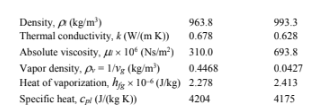The energy released by a hurricane comes from
A) cold Atlantic waters.
B) spiraling winds.
C) warm, moist air above warm, tropical oceans.
D) the Sun.
Answer: C
You might also like to view...
What property do greenhouse gases have that allow them to warm a planet?
What will be an ideal response?
A charged particle creates an electric ________ in the space around it
Fill in the blank(s) with correct word
Calculate the average heat transfer coefficient for film-type condensation of water at pressures of 10 kPa and 101 kPa for (a) a vertical surface 1.5-m-high (b) the outside surface of a 1.5-cm-OD vertical tube 1.5-m-long (c) the outside surface of a 1.6-cm-OD horizontal tube 1.5-m-long and (d) a 10-tube vertical bank of 1.6-cm-OD horizontal tubes 1.5-m-long. In all cases, assume that the vapor velocity is negligible and that the surface temperatures are constant at 11°C below saturation temperature.
GIVEN
? Film condensation of water
FIND
The average heat transfer coefficient at pressure of 10 kPa and 101 kPa for
(a) A vertical surface of height (H) = 1.5 m
(b) The outside surface of a vertical tube Outside diameter (D) = 1.6 cm = 0.016 m
Height (H) = 1.5 m
(c) The outside surface of a horizontal tube Outside diameter (D) = 1.6 cm = 0.016m
Length (L) = 1.5 m
(d) A 10 tube vertical bank of horizontal tubes Outside diameter (D) = 1.6 cm
Length (L) = 1.5 m
ASSUMPTIONS
? Steady state
? Vapor velocity is negligible
? Surface temperatures (Ts) are constant at 11°C below saturation temperature
? Film thickness is much smaller than the pipe diameter
? Laminar condensate flow
SKETCH

PROPERTIES AND CONSTANTS
From Appendix 2, Table 13, the saturation temperatures for water at
101 kPa (Tsv1) = 100°C, therefore Ts = Tsv – 11°C = 89°C
10 kPa (Tsv2) = 45.3°C, therefore, Ts = 34.3°C
The film temperatures, as given in Section 9.4.1 are
Tfilm1 = Ts + 0.25 (Tsv – Ts) = 89°C + 0.25 (11°C) = 91.8°C
Tfilm2 = 34.3°C+ 0.25 (11°C) = 37.1°C
From Appendix 2, Table 13, for water at the film temperatures


This diagram shows the approximate depths to which different wavelengths of light penetrate Earth's atmosphere. Why does it show an airplane?
A) Much of the infrared spectrum can be observed from an airplane that flies above most clouds. B) Airplanes are useful for astronomical observations at all wavelengths of light that do not reach the ground. C) Telescopes on airplanes are better than telescopes on the ground for both visible-light and infrared observations. D) The airplane is just decorative, indicating that astronomers use airplanes to fly to ground-based observatories.